
Twice the price of a Yoshinoya beef bowl, but more than it seems.
Our Japanese-language reporter Seiji Nakazawa recently moved to Tokyo’s Shibuya district. Even though he’s been living in the capital for several years, Seiji hadn’t spent much time in Shibuya before finding his new apartment, so since settling in he’s been exploring the neighborhood.
Though there aren’t any parts of Tokyo that would be considered straight-up dangerous by most other countries’ standards, Shibuya’s backstreets do have a bit of a sketchy reputation, so Seiji’s been doing most of his exploration during the day. For instance, at nighttime he’d probably have avoided this street with the Dotonbori Gekijo strip show theater on it…
…but strolling past it in the afternoon sunlight, he found something equally eye-catching right next door.
Between the strip theater and a ramen joint on the corner is Niku Dress, also known as Meat Dress. It’s a restaurant that specializes in donburi (rice bowls), and out front they had a sign touting their gyudon, or beef bowls.
The one that grabbed Seiji’s attention? The aburami gyudon, a beef bowl made with not just kuroge wagyu beef, but fatty kuroge wagyu beef.
▼ Niku Dress’ full official name for the dish is “rice bowl topped with simmered fatty Japanese beef, onions, and ginger.”
An ironic part of Japanese food culture is that since most dishes aren’t particularly fatty, the ones that are can sometimes be quite unabashed about it. With steak in particular, marbled beef with plenty of fat is often considered the most flavorfully gourmet, but this was the first time Seiji had seen a humble beef bowl bragging about its fat content.
Curious to know (and eat) more, Seiji headed up the stairs to the restaurant’s entrance.
▼ The menu is bilingual, making ordering a snap even if you can’t read/speak Japanese.
You can customize your order with things like raw egg or extra rice, but Seiji opted for the standard version of the fatty beef bowl, which is priced at 935 yen (US$6.10). That’s honestly on the high side for gyudon, about double what you’d pay at Yoshinoya, but a kuroge wagyu meal for under 1,000 yen is also a pretty good deal, and it comes with miso soup and pickles.
Appearance-wise, the fatty gyudon didn’t look all that different from the beef bowls you can get at any major chain, aside from the meat being lighter in color.
Leaning in for a closer look, though, Seiji noticed that the fatty gyudon’s meat is cut into smaller strips than usual. It’s a sign that Niku Dress uses only the especially fatty cuts from the meat, and Seiji got the sense that a lot of care goes into making the dish.
Of course, all the care in the world wouldn’t matter if it tasted bad. So Seiji took a bite and…
…yeah, it was good. Here’s the thing, though: gyudon is almost always good. Despite how cheap most beef bowls are in Japan, gyudon is amazingly consistent in terms of quality, and while this fatty one was tasty, it didn’t immediately strike Seiji as anything all that special. Still, he couldn’t complain, and he left the restaurant feeling satisfied.
Later that day, though, Seiji happened to come upon a Yoshinoya branch.
As loyal readers know, we have a very full professional eating-stuff calendar here at SoraNew24. Because of that, Seiji realized that it’s been a while since he’d eaten a Yoshinoya gyudon, the baseline by which all other beef bowls in Japan are judged. With his memory of Yoshinoya’s exact flavor feeling a little hazy, he decided it was time to reacquaint his taste buds with it, so he stepped inside and ordered a gyudon.
At 468 yen, it was cheaper then Niku Dress’ fatty gyudon, but when he took a taste, he found out that the price wasn’t the only difference between them. After having eaten the fatty gyudon, Yoshinoya’s meat felt surprisingly sinewy, and Seiji also was more aware of how much of Yoshinoya’s flavor comes from the broth it’s simmered in. On the other hand, the fatty gyudon had had a meltier texture with more of the sweet notes of its flavor profile coming from the meat itself. What’s more, by using less broth, the rice in Niku Dress’ fatty gyudon keeps more of its consistency and flavor too.
▼ Yoshinoya
▼ Niku Dress fatty gyudon
So, oddly enough, Seiji found his appreciation for the fatty gyudon rapidly rising after eating his next, non-fatty beef bowl. We guess you could say that makes the fatty one a dish for fans who eat gyudon regularly enough to have developed a thoroughly cultured palate for it, since it shines brightest on the taste buds of those who can detect the subtle differences that set it apart.
Immediately after eating the fatty beef bowl, if you’d asked Seiji whether he saw a return trip to Niku Dress in his future, he wouldn’t have been sure. Now though, he could definitely see himself going back, so if you spot him walking around near the strip theater, remember that he’s just there for the beef.
Restaurant information
Kichijoji Niku Dress Kaisendon (Shibuya Dogenzaka branch) / 吉祥寺 肉ドレス海鮮丼(渋谷道玄坂店)
Address: Tokyo-to, Shibuya-ku, Dogenzaka 2-28-27, Shoichi Building 2nd floor
住所 東京都渋谷区道玄坂2-28-7 翔壱ビル2F
Open 11 a.m.-3 p.m., 4 p.m.-9 p.m.
Photos ©SoraNews24
● Want to hear about SoraNews24’s latest articles as soon as they’re published? Follow us on Facebook and Twitter!
[ Read in Japanese ]

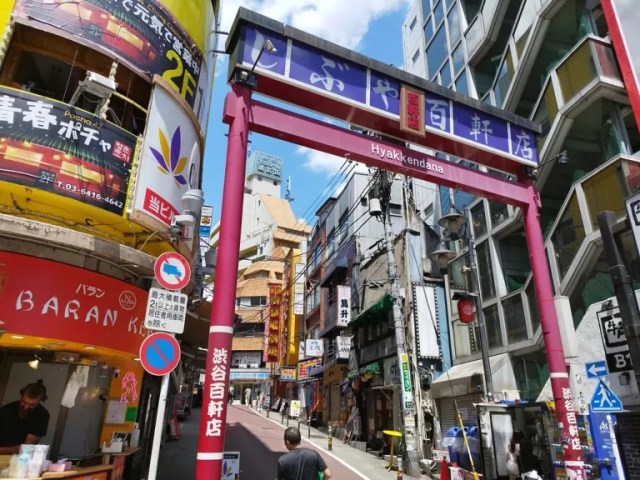



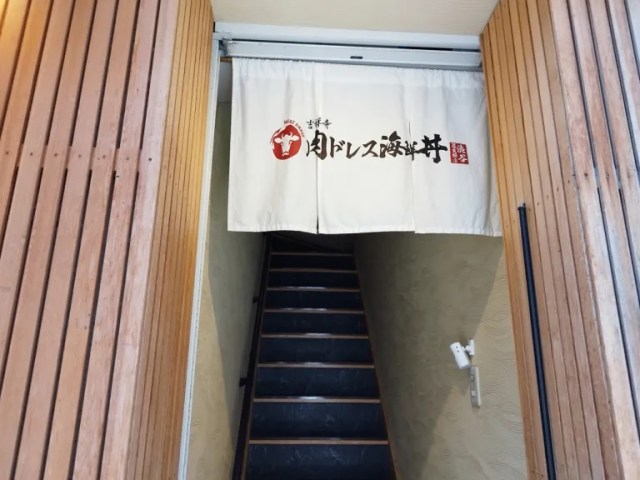
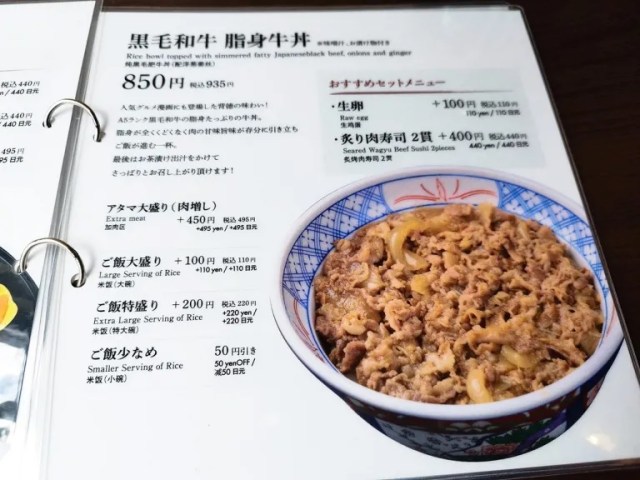
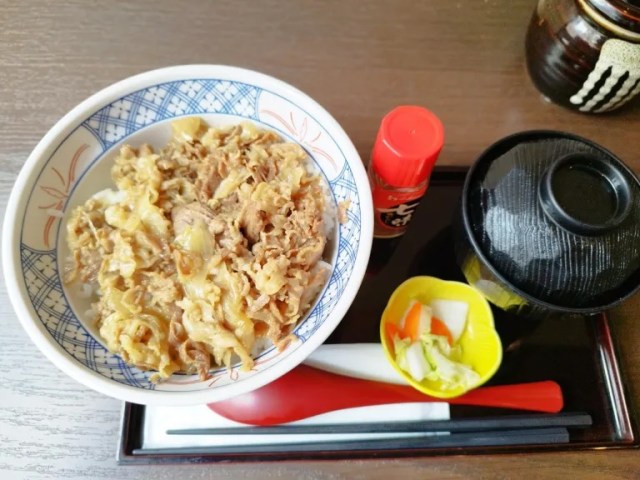
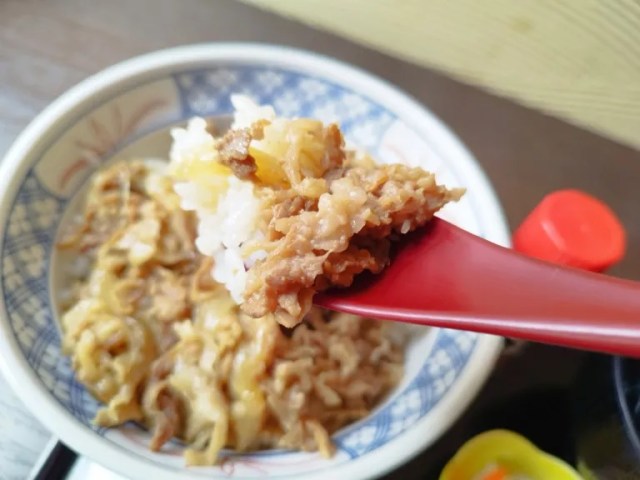
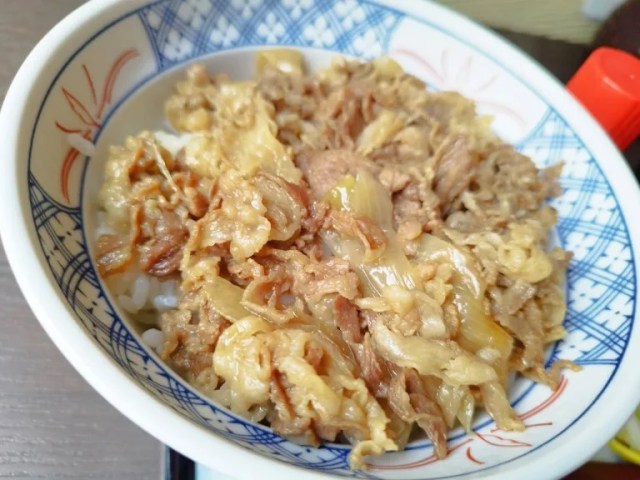




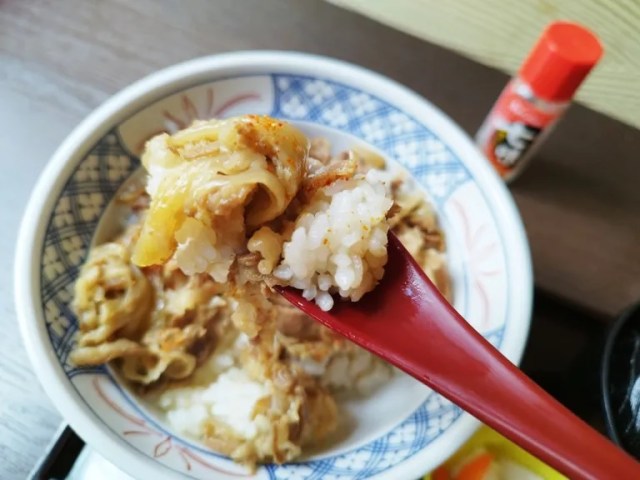
 Japanese Black Wagyu from Yoshinoya – Premium beef isn’t just for politicians anymore!【Taste test】
Japanese Black Wagyu from Yoshinoya – Premium beef isn’t just for politicians anymore!【Taste test】 Trying Yoshinoya for the first time in his life, is our Indonesian reporter impressed?【Taste test】
Trying Yoshinoya for the first time in his life, is our Indonesian reporter impressed?【Taste test】 Yoshinoya has a semi-secret chicken bowl you won’t find anywhere on its website【Taste test】
Yoshinoya has a semi-secret chicken bowl you won’t find anywhere on its website【Taste test】 From beef bowl to beef pouch? Taste testing Yoshinoya’s instant gyudon packs
From beef bowl to beef pouch? Taste testing Yoshinoya’s instant gyudon packs Yoshinoya sells frozen beef bowl topping packs, but are they as good as the restaurant kind?
Yoshinoya sells frozen beef bowl topping packs, but are they as good as the restaurant kind? Japan’s new difficult-to-drink-from beer glass protects your liver, but it’s a brutal experience
Japan’s new difficult-to-drink-from beer glass protects your liver, but it’s a brutal experience How to order snacks on a Shinkansen bullet train in Japan
How to order snacks on a Shinkansen bullet train in Japan Demon Slayer: Kimetsu no Yaiba gets new roller coaster attractions and food at Universal Studios Japan
Demon Slayer: Kimetsu no Yaiba gets new roller coaster attractions and food at Universal Studios Japan Come play hide-and-seek on a deserted Japanese island this August and November
Come play hide-and-seek on a deserted Japanese island this August and November Caffeinated ramen for gamers that you can eat with one hand going on sale in Japan
Caffeinated ramen for gamers that you can eat with one hand going on sale in Japan Japan’s foreign population reaches historic milestone following largest-ever single-year surge
Japan’s foreign population reaches historic milestone following largest-ever single-year surge New samurai glasses are Japan’s latest weird must-have souvenir
New samurai glasses are Japan’s latest weird must-have souvenir Infographic shows how working culture differs across the globe
Infographic shows how working culture differs across the globe New Pokémon ice cream, dessert drinks, and cool merch coming to Baskin-Robbins Japan【Pics】
New Pokémon ice cream, dessert drinks, and cool merch coming to Baskin-Robbins Japan【Pics】 Hello, cosmetics! Clinique teams up with Hello Kitty this summer for first-time collaboration
Hello, cosmetics! Clinique teams up with Hello Kitty this summer for first-time collaboration Nintendo history you can feel – Super NES, N64, and GameCube controllers become capsule toys
Nintendo history you can feel – Super NES, N64, and GameCube controllers become capsule toys “The most Delicious Cup Noodle in history” – Japan’s French Cup Noodle wins our heart【Taste test】
“The most Delicious Cup Noodle in history” – Japan’s French Cup Noodle wins our heart【Taste test】 Starbucks releases a cute Frappuccino and Unicorn Cake…but not in Japan
Starbucks releases a cute Frappuccino and Unicorn Cake…but not in Japan Kyoto Tower mascot termination reveals dark side behind cute Japanese characters
Kyoto Tower mascot termination reveals dark side behind cute Japanese characters McDonald’s Japan’s Soft Twist Tower: A phantom ice cream only sold at select branches
McDonald’s Japan’s Soft Twist Tower: A phantom ice cream only sold at select branches Yabai Ramen: What makes this Japanese ramen so dangerous?
Yabai Ramen: What makes this Japanese ramen so dangerous? Finally! Nintendo Japan expands Switch 8-bit controller sales to everybody, Online member or not
Finally! Nintendo Japan expands Switch 8-bit controller sales to everybody, Online member or not Japanese government wants to build luxury resorts in all national parks for foreign tourists
Japanese government wants to build luxury resorts in all national parks for foreign tourists To combat declining birth rate, Japan to begin offering “Breeding Visas” to foreigners
To combat declining birth rate, Japan to begin offering “Breeding Visas” to foreigners 10 things you should buy at 7-Eleven in Japan
10 things you should buy at 7-Eleven in Japan Studio Ghibli releases anime heroine cosplay dresses that are super comfy to wear
Studio Ghibli releases anime heroine cosplay dresses that are super comfy to wear Woman charged for driving suitcase without a license in Osaka
Woman charged for driving suitcase without a license in Osaka Studio Ghibli unveils My Neighbour Totoro miniature house model
Studio Ghibli unveils My Neighbour Totoro miniature house model Kyoto experiencing problems with foreign tourists not paying for bus fares, but not on purpose
Kyoto experiencing problems with foreign tourists not paying for bus fares, but not on purpose Fighting mild hunger with a Japanese soda that turns into jelly in the stomach【Taste test】
Fighting mild hunger with a Japanese soda that turns into jelly in the stomach【Taste test】 Studio Ghibli’s Howl’s Moving Castle tapestry unveiled in Japan for first time
Studio Ghibli’s Howl’s Moving Castle tapestry unveiled in Japan for first time McDonald’s new Happy Meals offer up cute and practical Sanrio lifestyle goods
McDonald’s new Happy Meals offer up cute and practical Sanrio lifestyle goods Sales of Japan’s most convenient train ticket/shopping payment cards suspended indefinitely
Sales of Japan’s most convenient train ticket/shopping payment cards suspended indefinitely Sold-out Studio Ghibli desktop humidifiers are back so Totoro can help you through the dry season
Sold-out Studio Ghibli desktop humidifiers are back so Totoro can help you through the dry season Japanese government to make first change to romanization spelling rules since the 1950s
Japanese government to make first change to romanization spelling rules since the 1950s Foreigner’s request for help in Tokyo makes us sad for the state of society
Foreigner’s request for help in Tokyo makes us sad for the state of society Ghibli founders Toshio Suzuki and Hayao Miyazaki contribute to Japanese whisky Totoro label design
Ghibli founders Toshio Suzuki and Hayao Miyazaki contribute to Japanese whisky Totoro label design Doraemon found buried at sea as scene from 1993 anime becomes real life【Photos】
Doraemon found buried at sea as scene from 1993 anime becomes real life【Photos】 Tokyo’s most famous Starbucks is closed
Tokyo’s most famous Starbucks is closed Princesses, fruits, and blacksmiths: Study reveals the 30 most unusual family names in Japan
Princesses, fruits, and blacksmiths: Study reveals the 30 most unusual family names in Japan What does three months of Yoshinoya beef bowls do to your body? Medical study announces results
What does three months of Yoshinoya beef bowls do to your body? Medical study announces results Does US$50 canned wagyu beef make for a great beef bowl? We find out【Taste test】
Does US$50 canned wagyu beef make for a great beef bowl? We find out【Taste test】 Meat lovers, you can now satisfy your carnivorous cravings at this revolving sushi restaurant!
Meat lovers, you can now satisfy your carnivorous cravings at this revolving sushi restaurant! Yoshinoya’s wagyu beef box for Japanese politicians
Yoshinoya’s wagyu beef box for Japanese politicians Japanese hamburger chain replaces buns with beef patties for awesomely crazy sandwich
Japanese hamburger chain replaces buns with beef patties for awesomely crazy sandwich Yoshinoya has an ultra-luxurious wagyu beef bowl you can only get one place in Japan【Taste test】
Yoshinoya has an ultra-luxurious wagyu beef bowl you can only get one place in Japan【Taste test】 How to make a mouth-watering Japanese beef bowl in just five minutes 【RocketKitchen】
How to make a mouth-watering Japanese beef bowl in just five minutes 【RocketKitchen】 Yoshinoya’s year-end lucky bag is more like a lucky box… or bowl?
Yoshinoya’s year-end lucky bag is more like a lucky box… or bowl? Crazy expensive “phantom beef” instant curry — Dream come true or edible nightmare?【Taste test】
Crazy expensive “phantom beef” instant curry — Dream come true or edible nightmare?【Taste test】 Beautiful beefy Yoshinoya gacha capsule toys look good enough to eat or display【Photos】
Beautiful beefy Yoshinoya gacha capsule toys look good enough to eat or display【Photos】 Japan’s beef bowl king, Yoshinoya, releases new line of canned, ready-to-eat beef bowls
Japan’s beef bowl king, Yoshinoya, releases new line of canned, ready-to-eat beef bowls Try this netizen’s “secret menu” item beef bowl at Yoshinoya, if only to see what the heck it’s about
Try this netizen’s “secret menu” item beef bowl at Yoshinoya, if only to see what the heck it’s about Japanese beef bowl chain Yoshinoya releases new canned, ready-to-eat rice bowls 【Taste Test】
Japanese beef bowl chain Yoshinoya releases new canned, ready-to-eat rice bowls 【Taste Test】 Yoshinoya, Japan’s biggest beef bowl chain, is now serving fried chicken in Tokyo
Yoshinoya, Japan’s biggest beef bowl chain, is now serving fried chicken in Tokyo Hello Kitty and Badtz-maru grace high-class Arita-yaki ceramic Yoshinoya bowl that could be yours
Hello Kitty and Badtz-maru grace high-class Arita-yaki ceramic Yoshinoya bowl that could be yours
Leave a Reply